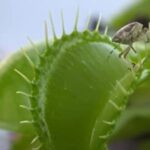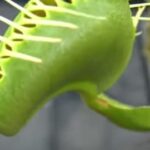As an Amazon Associate, this site earns commissions from qualifying purchases. For more details, click here.
Venus flytraps are best known for one thing, their ability to capture and eat worms, arachnids and small insects. So much so that some people get these plants to get rid of annoying bugs. But just how effective are Venus flytraps as insect killers?
Venus flytraps can only catch about 5-7 insects a month, and each takes several days to digest. Pitcher plants, butterworts and other carnivorous plants are more effective in eliminating insects.
Are Venus Flytraps Effective Bug Repellents?
There is no question Venus flytraps can eliminate some of the bugs around your garden. But do not expect them to get rid of all the flies, spiders etc.
Venus flytraps are not the most effective insect eater because that is not what they are supposed to do. These plants eat bugs for nutrients and not to keep your home free from pests. If there are pests in your plants and garden, it is better to use a spray like Wondercide to get rid of them.
Venus flytraps can only eat insects that fit in their mouths or traps. The average trap is 1-1.5 inches, with the B-52 variant trap around 2 inches. These are sufficient for flies, grasshoppers, beetles, ants and other small insects. It cannot catch small lizards, cockroaches and large bugs.
A Venus flytrap consumes insects for nutrition. When an insect falls into one of is traps, the plant releases digestive enzymes to digest it.
If your Venus flytrap is small its traps will be even less potent against large bugs. Even if the traps were sizable, its dietary habits make it less than efficient in deterring large numbers of insects.
When the plant has finished with the insect, the trap opens so the wind can carry away the leftover husk. A Venus flytrap takes 5 days to digest a bug and 12 days before the trap is opened again. And it can go several weeks without consuming another bug.
A Venus flytrap can have as many as five traps at a time. But it is very unlikely that they will all be full. Most of the time the plant only needs one trap to catch a prey and it will be sufficient to meet its nutritional needs.
If you have pest problems in your garden, use insecticide or find out the cause and how to eliminate them. A Venus flytrap can be helpful in getting rid of flies, but do not rely solely on it.
How Many Insects Can a Venus Flytrap Catch?
In theory a Venus flytrap can hold up to 12 insects a month. But in reality will probably be 5-7 at most because the plant only feeds when needed.
A Venus flytrap needs seven traps to capture 12 bugs a month. Each of those traps must capture a prey and after reopening after 12 days, all the traps must catch at least five more insects.
That is a very unlikely scenario for many reasons. For one, Venus flytraps use a lot of energy when they open the traps and digest food.
Once a Venus flytrap captures a prey, the digestive process starts. These plants are not poisonous to humans, dogs or cats, but the digestive enzymes are fatal to insects.
It takes 3 to 5 days for the plant to digest an insect. It may take another week before the trap opens again.
Why does it take so long for the trap to reopen? Because it does not have to eat again soon. Feeding one trap is enough to satisfy the nutritional quota of the entire plant.
While these plants are not sentient, they have an amazing ability for sustainability. They will not waste energy opening the traps once their needs are met.
So do not be disappointed if your Venus flytrap does not catch as many insects as you might have expected. Since the traps are only good for 3 to 5 uses, the plant is careful not to expend energy if it is not all necessary.
There are cases where Venus flytraps will catch several bugs. But it is not a good idea to rely on them exclusively to deal with pesky insects.
There is risk of overfeeding a Venus flytrap, and its traps can only hold so many bugs. Venus flytraps are more effective catching insects outdoors. There are more of pests outside so its chances of getting one are higher.
How Effective are Venus Flytraps vs. Other Carnivorous Plants?
The traps of a Venus flytrap can open and close a few times before it shuts down completely. However the plant will grow replacement leaves to take their place.
While Venus flytraps do a good job of catching bugs, it is not as proficient as a pitcher plant. Several Venus flytraps lined up will be more effective in catching insects though.
If you prefer to keep the plant indoors, place it close to the window where its trap can lure flies and other bugs. If you really want to use these as insect repellents, get several and position place them at the appropriate location, i.e. where you see the insects.
One thing to keep in mind about Venus flytraps and all carnivorous plants. They eat bugs out of necessity. These plants grow in poor soil so they resort to insects to get the nutrients they need.
If a Venus flytrap receives sufficient food, it will not go after insects as much. If you feed it TruBlu Venus Flytrap Food for instance, this will be enough to meet the needs of the plant.
This is important if your plant is indoors and there are limited prey. Using the right soil is also required to ensure the Venus flytrap is well cared for.
Venus flytraps feed on insects because they have to. And this is also the reason why they will never get rid of all of them. Nature has to balance the plants’ need for food while ensuring there is enough of the creatures to feed them.
This is why Venus flytraps have a limited number of traps and why they can go for months without eating bugs. If carnivorous plants consumed all insects they would run out of food.
The Best Way to Use Venus Flytraps to Catch Flies
In a typical home where you see a fly or two, a Venus flytrap cannot do much. It is another thing if there are lots of flies. In that case a Venus flytrap would be effective.
The best way to use Venus flytraps and other carnivorous plants is to fight off fruit infestation. If you grow fruits you know how quickly flies can get to them, but having a few of these insect eating plants should take care of them.
There are a lot of carnivorous plants to choose from, but Venus flytraps are still a good option. Though their traps have limitations, you can count on them to catch flies. Its traps produce a scent that draws them and other insects.
For this to work you should place the Venus flytraps as close to the fruits as possible. You will need several of these plants if you have a large fruit garden, but you are not limited to Venus flytraps.
Pitcher plants, butterworts and sundew plants are all effective in getting rid of fruit flies. Each one has its own unique way of luring its prey, so having these in your garden will keep your fruits free from pests.
If there is leftover food on the table and it draws flies, a Venus flytrap can help. Instead of the food the insects will be drawn to its traps. Under these circumstances, the plant will be able to catch several bugs at the same time.
If you do not have a fruit garden and just deal with the occasional house fly, Venus flytraps will be less effective. In these cases make sure the plant receives sufficient food to compensate for the lack of prey around it.
Conclusion
Venus flytraps are cool to watch when they spring their traps to catch a bug. But these plants are not insect repellents. It is something the plant does to live, and it just so happens we benefit from it. But you should not get a Venus flytrap solely for pest control purposes.

My fascination with carnivorous plants began many, many years ago with Venus Fly Traps. Now I am more than happy to impart what I know with other enthusiasts and those who are curious about meat eating plants.



